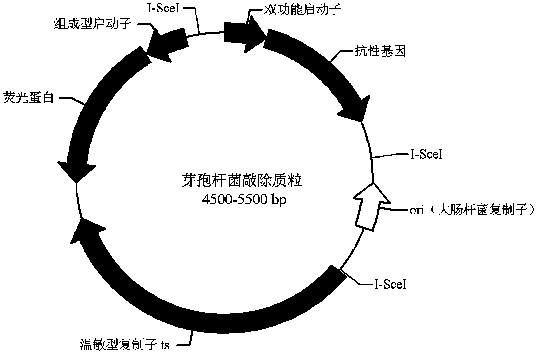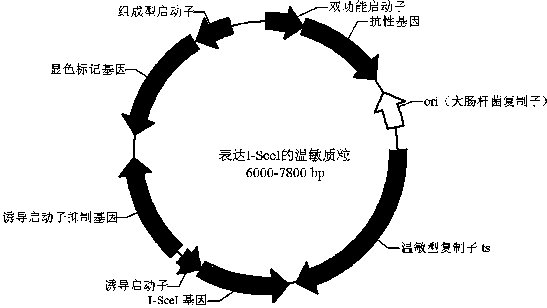Bacillus gene traceless knockout/knockin plasmid and method, and kit
A bacillus, traceless knockout technology, applied in the field of genetic engineering, can solve the problems of low success rate, low probability of gene knockout or knockin, long cycle, etc., and achieve the effect of improving efficiency, easy gene manipulation and plasmid transformation
- Summary
- Abstract
- Description
- Claims
- Application Information
AI Technical Summary
Problems solved by technology
Method used
Image
Examples
Embodiment 1
[0059] Example 1 Knockout plasmid pEBKS194-GFP+ containing I-SceI restriction site
[0060] As mentioned in the content of the present invention, the knockout plasmid containing the I-SceI restriction site can be in various combinations. This example will describe in detail the construction process of one of the plasmid forms, pEBKS194-GFP+. All primer sequences are listed in Table 1.
[0061] Construction of vector pWEBKS3
[0062] Using the expression plasmid pWEBK15 in the CN201410430501.3 patent (the only antibiotic resistance gene in this plasmid is the kanamycin resistance gene) as a template, use the phosphorylated upstream and downstream primers F1 and R1 to carry out PCR amplification of the whole plasmid , the amplified product was digested overnight at 37°C with restriction endonuclease DpnI, recovered, digested with BglII, ligated, transformed into Escherichia coli DH5α, spread on a 50 μg / mL kanamycin-resistant plate to screen positive clones, Sequencing with p...
Embodiment 2
[0069] Example 2 Construction of thermosensitive plasmid pTISWts-RFP expressing I-SceI enzyme
[0070]As mentioned in the content of the present invention, the temperature-sensitive helper plasmid expressing I-SceI enzyme can be in various combinations. This example will describe in detail the construction process of one of the plasmid forms, pEBTWts-RFP. All primer sequences are listed in Table 1.
[0071] (1) Construction of vector pHYWVts
[0072] Using the pHY300PLK vector (the antibiotic resistance gene of the plasmid has tetracycline resistance gene and ampicillin resistance) as a template, the vector fragment is amplified with primers F8 and R8; the synthetic thermosensitive replicon DNA fragment (SEQ ID NO.16) As a template, primers F9 and R9 were used to amplify the gene fragment of the temperature-sensitive replicon WVts. The amplified products of the gene fragment and the vector fragment were digested with DpnI enzyme overnight (37°C) and then recovered. The car...
Embodiment 3
[0077] Knockout of the aprE gene in the Bacillus subtilis CICC10073 bacterial strain of embodiment 3
[0078] (1) Construction of knockout vector pKS194GFP-aprEUD
[0079] Adopt CTAB (cetyltrimethylammonium bromide) method to extract the genomic DNA of bacillus as the template of gene amplification (reference literature: Acta Microbiology, 2006,46 (1): 7-12.); Bacillus CICC10073 genomic DNA was used as a template, primers F14 and R14 were used as primers to amplify the upstream homology arm aprE-UP of the aprE gene, primers F15 and R15 were used as primers to amplify the downstream homology arm aprE-down of the aprE gene; pEBKS194- The GFP+ plasmid was used as a template, and the vector fragment was amplified with primers F4 and R6. The amplified product of the vector fragment was digested with DpnI enzyme at 37°C overnight and then recovered. Connect and transform Escherichia coli DH5α, spread on a 50 μg / mL kanamycin resistance plate to screen positive clones, use primers ...
PUM
 Login to View More
Login to View More Abstract
Description
Claims
Application Information
 Login to View More
Login to View More - R&D
- Intellectual Property
- Life Sciences
- Materials
- Tech Scout
- Unparalleled Data Quality
- Higher Quality Content
- 60% Fewer Hallucinations
Browse by: Latest US Patents, China's latest patents, Technical Efficacy Thesaurus, Application Domain, Technology Topic, Popular Technical Reports.
© 2025 PatSnap. All rights reserved.Legal|Privacy policy|Modern Slavery Act Transparency Statement|Sitemap|About US| Contact US: help@patsnap.com



